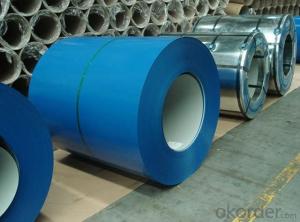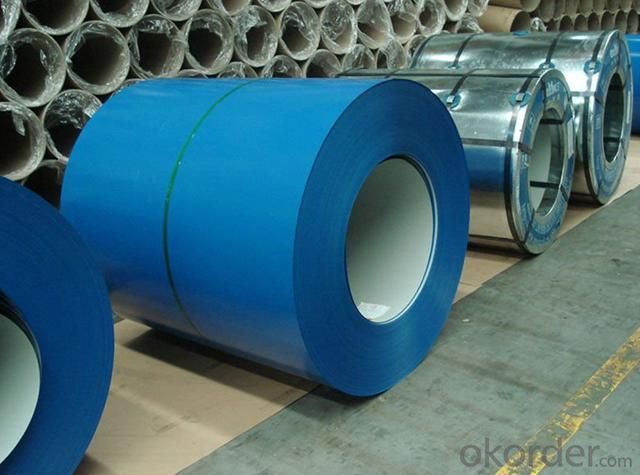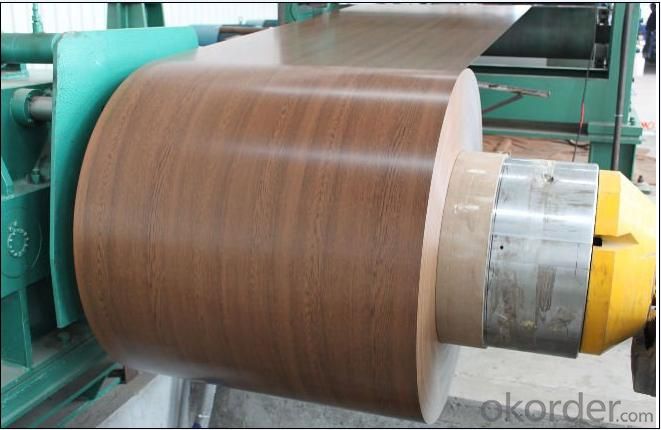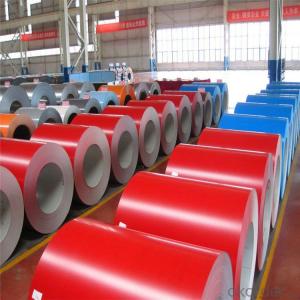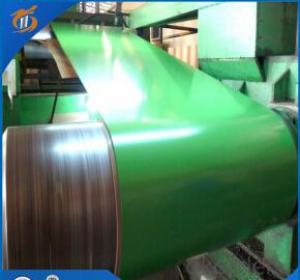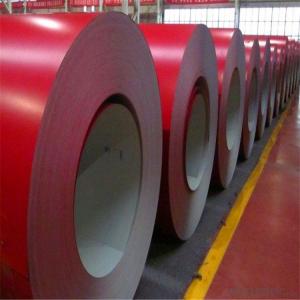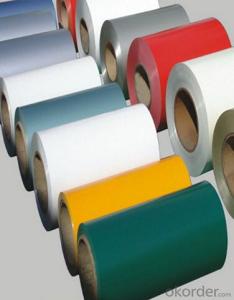Color Coated PPGI for Building Materials
- Loading Port:
- Tianjin
- Payment Terms:
- TT OR LC
- Min Order Qty:
- 50 m.t.
- Supply Capability:
- 10000 m.t./month
OKorder Service Pledge
OKorder Financial Service
You Might Also Like
Product Details
Basic Info.
Model NO.:CGCC CGCH
Standard:ASTM, JIS, GB, AISI
Steel Grade:Q195 Q235
Certification:ISO, SGS, BV, RoHS
Surface Treatment:Galvanized
Technique:Cold Rolled
Edge:Mill
Stock:Stock
Thickness:0.15-0.8mm
Width:800mm-1250mm
Zinc Coating:30-120G/M2
Coil Weight:3-6 Tons
Type of Coating:Galvanized
Dlivery Time:in 30 Days
MOQ:25 Mt
Export Markets:Global
Additional Info.
Packing:Standard Seaworthy Package
Standard:0.15-0.8mm*800-1250mm
Origin:Shandong Province. China
HS Code:7210701000
Production Capacity:300000 Tons / Year
Product of Description
NAME: Color Coated Galvanized Steel Coil/PPGI
SIZE:
Thickness: 0.12-1.2mm
Width: 600mm-1250mm (STD914mm,1000mm, 1200mm, 1219mm, 1250mm)
Thickness tolerance: +/-0.02mm or control in 0.1 according to customer's requirement
Width tolerance: +/-2mm
Zinc, Paint & Color
Zinc coating: 30-120G/M2
Paint thickness: Top 13-20um + Back 5-10um
Color: As the RAL color standard or customer's sample
Hardness: normal hard (HRB 65); full hard (HRB95) or as per your request
Packing
1. Coil weight: 3-6 tons
2. Coil ID: 508mm\610mm
3. Inner side: By water proof kraft paper and plastic packing.
4. Outside: Covered by steel sheet, bundled the sheets with steel strips.
5. Standard sea worthy package or special packing method as per your request
Standard
JIS G 3312, ASTM A755, EN10169,GB/T2518
Base sheet: Galvanized steel coils\ Galvalume steel, such as SGCC, CGCC, DX51D+Z, Q195,etc
Base metal: Hot galvanized steel or PrePainted Galvanized aLuminium steel or HBR>85
Techinque: Cold rolled, hot-dipped galvanizing, color coated
Quality: CQ DQ prime
Payment and Delivery Time
1. Payment: 30% T/T as deposit and 70% balance irrevocable L/C at sight or nogotiate
2. Delivery Time: 10-20 days after recepit of 30% T/T.
Application
Outdoor: Roof\ Roof structure\Surface sheet of balcony\ Frame of window\Door of garage\Roller shutter door\Persian blinds\Cabana and so on.
Indoor: Door\Isolater\Frame of door\Light steel structure of house\\Folding screen\Ceiling\Internal decoration of toilet and elevator.
Building accessories: Window panels, signboards Home appliances: Oil/gas boilers, rice buckets, portable gas burners, etc.
| Commodity | Color Coated Galvanized Steel Coil/PPGI |
| Techinical Standard | ASTM, JIS, GB, AISI, DIN, BS |
| Grade | Q195 Q235 Q235B SGCC DC51D DC52D DC51D+Z |
| Thickness | 0.15-0.8mm |
| Width | 800-1250mm |
| Coil weight | 3-6tons |
| Type of coating | Galvanized |
| Zinc coating | 30-120G/M2 |
| Coil ID | 508mm or 610mm |
| MOQ | 25 MT |
| Supply capacity | 300000MT/per year |
| Package | standard sea worthy package |
| Origin | Shandong Province.China |
| Trademark | yuanda |
| Application | Industrial panels, roofing and siding for painting |
| Price terms | FOB, CFR, CIF |
| Payment terms | 30%T/T in advance+70% T/T or irrevocable 100% L/C at sight |
| delivery time | 10-20 days after recepit of 30% T/T |
| Remarks | Insurance is all risks |
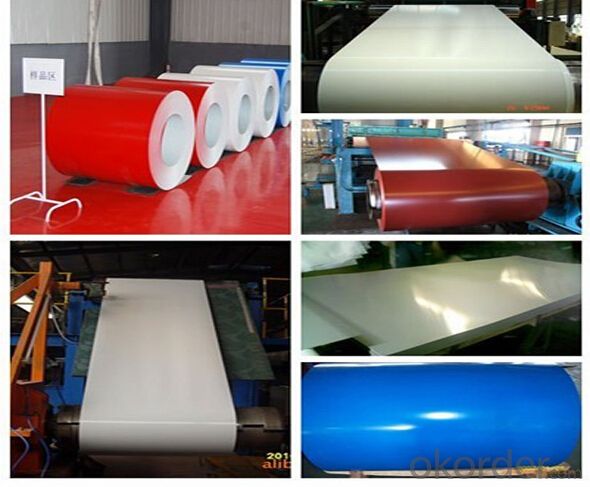
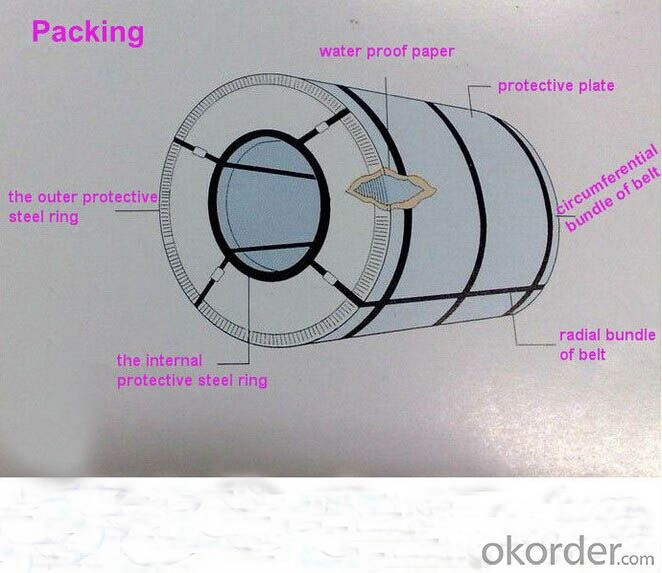
FAQ:
1. What is the minimum order quantity ?
Our MOQ is 50mt for each size. And we will consider to give more discount if you make big order like 1000 tons and more. Further more, the more appropriate payment term your offer the better price we can provide.
2. How long can we receive the product after purchase?
Usually within thirty working days after receiving buyer’s advance payment or LC. We will arrange the factory manufacturing as soon as possible. The cargo readiness usually takes 15-25 days, but the shipment will depend on the vessel situation.
3. How to guarantee the quality of the products?
We have established the international advanced quality management system,every link from raw material to final product we have strict quality test;We resolutely put an end to unqualified products flowing into the market. At the same time, we will provide necessary follow-up service assurance.
4.What is the validity of your quotation?
Normally 7 days.
5.What is your advantage?
24 hour quick response /Customer oriented/ Credit foremost/ Top quality Excellent
- Q: How do steel coils impact the environment?
- Steel coils impact the environment in several ways. Firstly, the production of steel coils requires large amounts of energy and resources, leading to increased greenhouse gas emissions and depletion of natural resources. Additionally, the manufacturing process generates air and water pollution, contributing to environmental degradation. Furthermore, the disposal of steel coils after use can result in land pollution if not properly managed. Overall, the production and use of steel coils have a significant environmental footprint.
- Q: what is the differance between ceramic and stainless steel headers and 4-2-1 and 4-1 and which are better for racing and should i get ceramic or stainless steel headers???? for a 98 civic
- 1) okorder ... The top two are of 4-1 design. Good luck, have fun.
- Q: Why is iron used to create steel? Why not other elements?
- iron came before steel. iron is what was discovered that, under certain circumstances, became a stronger metal: steel. that is why. its like asking why copper is in bronze. because what we call bronze, is an alloy of copper and tin. if you give a more detailed question, i may be able to give a more detailed answer.
- Q: On how to reinforce steel coils in a container
- In the bottom and sides with a thick strip stuck, but also to ensure that the wood will not loosen down...... Rough steel rolls, I saw people loading and unloading on the docks, poked them directly with a small forklift truck, and then reinforced with wooden planks
- Q: What exactly is surgical stainless steel made of (metals)? Does it contain nickel? If so, what % does it usually contain? I am deciding between surgical stainless steel piercings or titanium. Both same price and looks. I want to know which one is more hypo-allergenic and generally nickel free.
- surgical stainless steel is an austenitic steel containing 18-20% chromium and 8-10% nickel. and some proportion of molybdenum. The word 'surgical' refers to the fact that these types of steel are well-suited for making surgical instruments: they are easy to clean and sterilize, strong, and corrosion-resistant. The nickel/chrome/molybdenum alloys are also used for orthopaedic implants as aids in bone repair, and as a structural part of artificial heart valves and other implants. However, immune system reaction to nickel is a potential complication. In some cases today titanium is used instead in procedures that require a metal implant which will be permanent. Titanium is a reactive metal, the surface of which quickly oxidizes on exposure to air, creating a microstructured stable oxide surface. This provides a surface into which bone can grow and adhere in orthopaedic implants but which is incorrodible after implant. Thus steel may be used for temporary implants and the more expensive titanium for permanent ones
- Q: What are the typical dimensions of a steel coil?
- The typical dimensions of a steel coil can vary depending on its specific application and industry. However, common dimensions for steel coils include a width ranging from 0.5 inches to 72 inches, and a thickness ranging from 0.010 inches to 0.625 inches. The inner diameter of the coil is usually between 16 inches and 24 inches, while the outer diameter can range from 48 inches to 72 inches.
- Q: I need to say how a bottle opener is made, would it be made from steel and can this be coloured? How?
- Steel can be plated(Chrome),Blackened(Black Oxide),Powder coated(color of your choose).All of this is done to prevent rust.All of these aforementioned processes can be worn off through being used.I suggest polished Stainless steel.
- Q: Ok, so I'm obsessed with learning how to play the guitar (I preffer acoustic)... I'm a teenage girl that wants to play rock/pop/folk music... I want to learn first how to strum... then eventually how to pick...so what type of string is better? nylon or steel?
- A good number of teachers (in No.California) recommend nylon string guitars for beginner students for the following reasons: 1: Either (nylon strings or steel strings) type of acoustic guitar can play ANY type of music However,nylon strings are much easier (less punishing) on the fingers as well as you start learning to use your fingers (not a pick )to play. Many beginners with the steel-string like to start right away with the use of a pick to avoid the hardness of the steel strings and seldon move up to learn to use the bare fingers to play. 2: For those concern about volume many classical acoustic are built with an electric plug that can be utilize to hook into an amplifiying unit. 3: Once you learn to finger-play you are ahead of some players that started with a pick and have a difficult time to play without a pick. 4: Right hand (if a right-handed)finger dexterity is very important in playing the melody passages (harmony that depends primarily on chords) of any musical piece. 5: It is true that a nylon-string guitar brings out a more mellower sound and the steel-strings have a brighter (but tin-like) sound. Both can be heard clearly in a standard living room environment without need of amplification. In the final analysis is a matter of personal choice. Most of my profesional guitar player friends have and play often both types of guitars. They play the nylon-string when in a group of players and they are assigned the 1st guitar music part. When they are playing harmony (back up) they seem to play more the steel-string instrument. A note of interest: Every player I know that plays classical guitar knows how to sight-read music while most other players that only play with a pick and steel-strings guitar use Tabs for playing. Either way it is you that have to decide. Try both instrument in the same piece of music (or strumm on both) and see which one you like. Good Luck and Enjoy whatever guitar you choose.
- Q: How do steel coils contribute to energy performance in buildings?
- Steel coils can contribute to energy performance in buildings by providing insulation and thermal efficiency. The coils are often used in HVAC systems to enhance the heating and cooling processes, thus reducing energy consumption and improving overall energy efficiency. Additionally, steel coils can be used in roofing and cladding systems, providing insulation and helping to maintain a comfortable indoor temperature. By effectively managing heat transfer and reducing energy loss, steel coils play a crucial role in enhancing energy performance in buildings.
- Q: How are steel coils inspected for yield strength?
- Steel coils are inspected for yield strength through a process called tensile testing. In this method, a small sample is cut from the steel coil and subjected to a controlled tension until it reaches its yield point. The amount of force required to deform the sample is measured, allowing for the determination of its yield strength.
Send your message to us
Color Coated PPGI for Building Materials
- Loading Port:
- Tianjin
- Payment Terms:
- TT OR LC
- Min Order Qty:
- 50 m.t.
- Supply Capability:
- 10000 m.t./month
OKorder Service Pledge
OKorder Financial Service
Similar products
Hot products
Hot Searches
Related keywords
